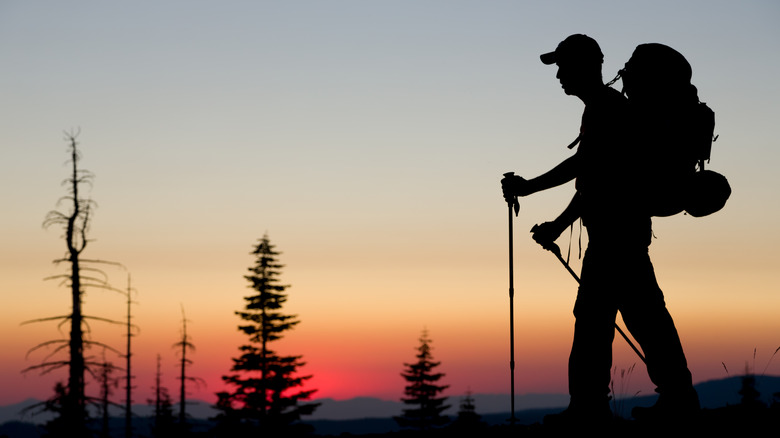This Popular West Coast Trail Is Considered One Of The Longest Hikes In America
Across the U.S., there are over 1,000 official national trails through the country's wilderness. Out of all these treks, the Pacific Crest Trail is one of the longest. The backpacking journey starts in Mexico and ends a whopping 2,665 miles later in Canada. Not only is PCT one of the country's longest hiking trips but it is also one of its most famous. In 1932, hiker Clinton Clarke began advocating for this trail along the West Coast to be preserved. In awe of the area's stunning landscapes, Clarke wanted to ensure it remained protected from urban development.
1963, the U.S. government officially established what is now known as the Pacific Crest National Scenic Trail. Every year, around 700 to 800 adventurers attempt to complete the entire length of the trail in one go. PCT travelers flock to this trail for a myriad of reasons, whether they're seeking a hiatus from modern life, a challenging hike, or ample time to reflect. Whatever the reason, it ought to be a good one, as the trail typically takes five months to complete.
What the terrain is like on the Pacific Crest Trail
The Pacific Crest Trail is no joke. Stretching along the entire span of California, Oregon, and Washington, hikers are faced with a diverse range of terrain and must be prepared for a myriad of challenges. Most people will begin their journey in Campo, California, just beside the Mexican border. Then they'll journey through Southern California encountering landscapes like the Laguna Mountains and the Mojave Dessert. Along the way, they'll encounter chaparral, pine forests, and more amidst generally warmer and dryer weather.
From there, hikers advance north towards the Oregon border. Throughout Central California, travelerblogrs will discover beautiful meadows and coniferous forests. In Northern California, they'll climb over the Marble and Siskiyou Mountains. Luckily, after all that, hikers are given somewhat of a break and faced with what's considered the easiest portion of the trail as they make their way from the Oregon border to Washington through Crater Lake National Park and past Mt. Hood.
For the last portion of this momentous voyage, hikers are faced with the wilderness terrain of Washington State. A portion of this stretch is thought to be the most strenuous difficult of the PCT: the 127 miles between Stevens Pass to Rainy Pass. Although this trail is strenuous, the wet, cold hike through the North Cascades Range offers stunning views of Glacier Peak. Finally, hikers complete their adventure at the Northern Terminus on the Canadian border.
General tips if you're considering completing the Pacific Crest Trail
Completing the Pacific Crest Trail is an extremely popular bucket list item. However, if you're considering taking on this expedition, remember that it is a serious decision to make. Of the 700-800 people who set out on the PCT, only 60% of them usually complete it. Not only is it difficult, but without proper planning, it can be highly dangerous. In fact, the Pacific Crest Trail Association suggests that prior physical training will take hikers about six to eight months. This is sometimes longer than it takes to hike the actual trail.
Because the trail does require an extensive amount of time, it's important that you time your departure and arrival properly. While hiking the PCT during the winter is not impossible, it is not recommended. Once snow covers the trail, conditions become much more dangerous and this exhilarating hike is not for amateurs. Hikers should leave around mid-April to finish the passage before cooler, harsher weather rolls through.
If it all sounds like too much for you, don't worry you're far from being alone. Every year, many people opt to simply do sections of the PCT, taking just a weekend or week to escape their routine and march along the West Coast.


